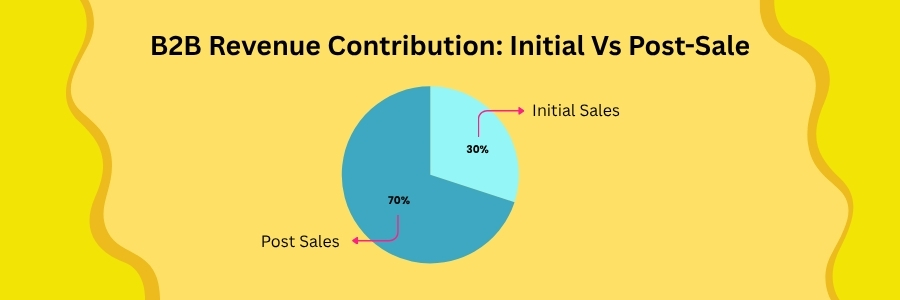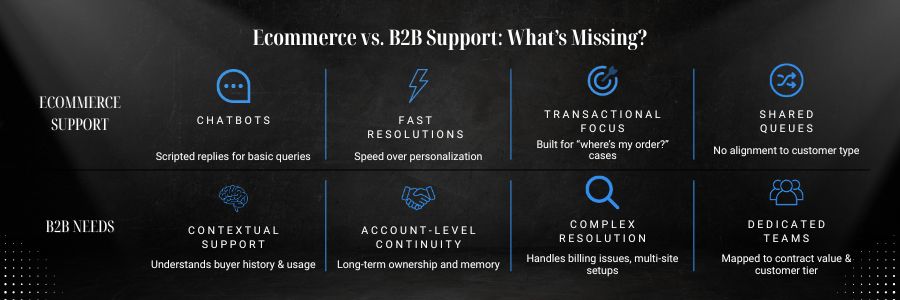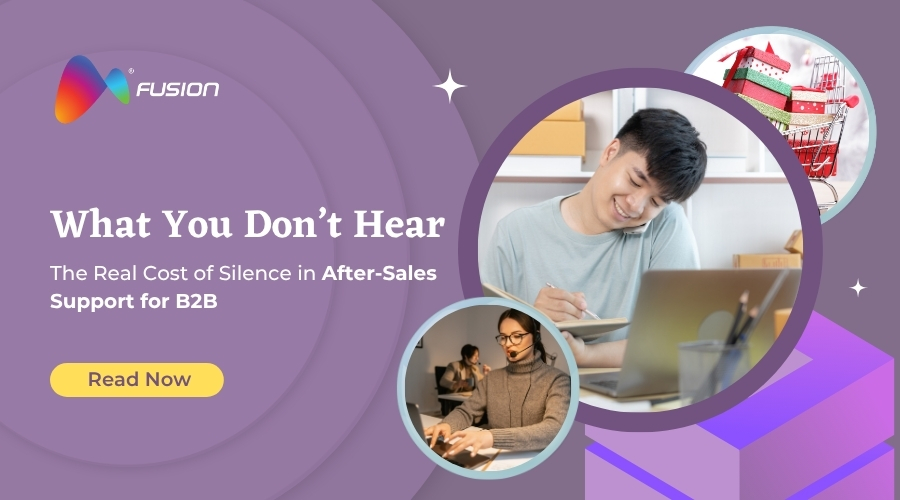In B2B marketplaces, the sale isn’t the end of the deal — it’s the beginning of a long-term relationship. While B2C transactions end at checkout, B2B deals are followed by onboarding, usage, reorders, and critical service moments. This means after-sales support for B2B isn’t just a support function — it’s a core pillar of your customer success and revenue strategy.
Yet, many marketplaces operate under the illusion that no news is good news. When buyers go quiet, leaders assume satisfaction — but often, that silence hides unmet expectations, lingering issues, and buyers quietly evaluating alternative vendors. A lack of support tickets doesn’t mean there’s no problem. It means missed signals.
Support isn’t just a department. In B2B, it’s your renewal strategy.
This blog explores why after-sales support for B2B marketplace is the new growth lever, how legacy ecommerce customer service models fail in enterprise contexts, and how you can redesign your support ecosystem to reduce churn, build loyalty, and drive lifetime value.
Why After-Sales Support for B2B Is Your Hidden Growth Lever
For B2B organizations, the real revenue begins after the initial transaction. In fact, Forrester reports that customer‑obsessed companies grow revenue 28% faster and achieve 43% better customer retention than their peers. Yet all too often, support teams remain focused on cost reduction—missing the revenue potential locked in post‑sale relationships.

Here’s why smart organizations are now viewing post-sale support as a strategic asset — not an operational afterthought.
- It Drives Renewals: Retention is cheaper than acquisition. When post-sale support is structured, responsive, and insightful, it reassures your buyer that they’ve chosen the right partner — and gives them fewer reasons to switch.
- It Powers Expansion: A well-handled support experience builds trust, and trust unlocks wallet share. Strategic post-sale conversations create opportunities to upsell complementary services, expand usage across departments, and deepen relationships.
- It Prevents Revenue Leakage: Support gaps often lead to operational inefficiencies, fulfillment errors, and churn that don’t appear on your sales radar until it’s too late. Proactive issue resolution and clear SLAs protect revenue — and your brand’s reputation.
In B2B, your buyer’s second order is a vote of confidence in how well you handled the first.
By contrast, ecommerce customer service models often focus on first-response time or ticket closure speed. While speed is critical, depth and continuity are more important in B2B. Buyers expect tailored responses, not templated scripts. They want long-term accountability, not just one-off resolutions.
This is why treating post-sale support with the same importance as sales and marketing isn’t just smart — it’s necessary.
What Happens When There’s No Structured After-Sales Support for B2B Marketplace
The absence of visible post-sale support doesn’t reduce problems — it buries them. In high-value B2B environments, this silence becomes dangerous. Without a framework for structured engagement, even the most satisfied buyer can quickly turn into a silent churn risk.
The Business Risks of Going Silent
When post-sale engagement lacks structure, the impact is felt across every part of the buyer relationship:
- Missed Renewals: Without proactive communication, there’s no visibility into contract health, usage issues, or upsell opportunities. Renewals are lost not because of product failure, but because of inattention.
- Escalated Churn: A simple miscommunication or unaddressed concern can spiral into distrust. The longer a buyer goes without hearing from you, the more likely they are to explore competitors.
- Reputation Damage: In B2B, relationships don’t end with one customer. Procurement leaders communicate — both internally across departments and externally across networks. One poor experience can close doors to multiple future accounts.
In B2B, silence isn’t passive — it’s corrosive.
The Invisible Cost of No Feedback Loops
Post-sale support isn’t just about issue resolution — it’s your best source of insight for product, process, and experience optimization. When that loop doesn’t exist, you’re operating blind.
- Product Blind Spots: Recurring defects, usage friction, or configuration gaps go unreported and unaddressed.
- Fulfillment and Service Gaps: If no one tracks repeat delivery issues or onboarding delays, they get normalized — until the account walks away.
- No Data for Sales or Success Teams: Your GTM engine loses context. Sales doesn’t know what post-sale issues are derailing renewal. Success doesn’t know when support has flagged critical accounts.
Without a structured framework, your business loses more than customer satisfaction — it loses operational clarity and growth momentum.
Why Ecommerce Customer Service Models Fall Short in B2B
When B2B marketplaces scale rapidly, many default to ecommerce customer service frameworks—automated ticketing systems, chatbots, or outsourced help desks. While these tools work well in transactional environments, they fall apart in complex, contract-based B2B ecosystems.

Where the Misalignment Begins
Ecommerce customer service is optimized for speed, consistency, and volume. It’s built for “where’s my package?” inquiries and quick refunds — not for resolving billing discrepancies in long-term agreements or triaging component failures that halt production lines.
B2B buyers require:
- Context-rich support that understands product configurations, integration dependencies, and usage history.
- Multi-layer resolution involving logistics, engineering, and finance teams — not just frontline reps.
- Continuity across interactions, with account-level memory, not ticket-by-ticket conversations.
In B2B, support isn’t just a touchpoint — it’s a trust contract.
Real-World Gaps That Erode Confidence
- Misrouted Tickets: Automated systems often assign high-value issues to generic queues, leading to delays and repeated explanations.
- Lack of Context: A chatbot may log a ticket, but it won’t understand that the issue affects a multi-site implementation worth six figures.
- No Account Ownership: When support teams aren’t aligned to specific accounts, continuity is lost — and so is accountability.
The result? Buyers feel unseen. Escalations rise. Loyalty drops.
Structured post-sale support is about more than answering inquiries. It’s about embedding strategic care into every post-sale interaction — something that ecommerce customer service models weren’t built to do.
What World-Class After-Sales Support for B2B Actually Looks Like
In the B2B world, buyers don’t just need support, they need partnership. World-class after-sales support for B2B isn’t reactive helpdesk interaction. It’s a strategic framework that nurtures long-term value, renewal, and loyalty.
Below are two foundational shifts that B2B marketplaces are making to elevate their post-sale experience:
From Reactive to Predictive
Traditional support waits for something to go wrong. Predictive support anticipates it — and solves it before it escalates.
Here’s how predictive support transforms outcomes:
- Tiered Support Models: Top-tier clients get faster SLAs, direct escalation paths, and proactive check-ins. This tiered model thrives on dedicated customer service that understands the account history and usage trends.
- Customer Health Monitoring: Track support frequency, product usage, and sentiment signals to identify accounts at risk of churn.
- Proactive Outreach: Instead of waiting for complaints, initiate touchpoints after critical milestones—like implementation, QBRs, or repeat orders.
In B2B, the best support conversations are the ones that happen before a ticket is raised.
When you shift from reactive firefighting to proactive care, you build credibility and reduce risk—before a buyer even senses friction. In fact, companies that implement guided, structured post-sale journeys have seen a 30% lift in net revenue retention.
Build a Post-Sale Command Center
A centralized, insight-rich hub for all post-sale activity enables scale, consistency, and visibility across teams.
Key components include:
- Integrated Systems: Connect your CRM, ticketing, knowledge base, and analytics platform. Everyone, from sales to support, works from the same data. By integrating tools across email, chat, and voice, we enable a unified omnichannel resolution strategy.
- Structured Review Cadence: Conduct quarterly touchpoints to surface friction areas, track CSAT/NPS, and realign on evolving buyer goals.
- AI-Powered Support Intelligence: Use machine learning to flag issue clusters, recurring complaints, or SLA breaches — so you fix root causes, not just symptoms.
This isn’t about more software. It’s about smarter orchestration. When your post-sale data, people, and processes work in sync, your buyers feel the difference.
How to Turn Post-Sale Chaos into Scalable After-Sales Support for B2B
Too often, after-sales support in B2B environments is reactive, fragmented, and underfunded. However, forward-thinking marketplaces are flipping the script — treating support not as a cost center, but as a customer experience engine that drives renewal, expansion, and competitive advantage.
Here’s a practical framework to operationalize that transformation:
Diagnose
Start with ruthless visibility. Audit your current post-sale support across channels, teams, and tools. Identify:
- Where tickets get lost or delayed
- Where buyers feel abandoned after escalation
- Where internal handoffs create friction
Look beyond average resolution times. Focus on how supported your buyers feel during the post-sale journey. Interview top accounts. Analyze churned customers. VOC isn’t just a metric — it’s your blueprint. With 84% of customer service and support leaders stating that customer data and analytics are crucial to achieving their goals, investing in structured feedback systems is no longer optional — it’s foundational.
Design
With gaps identified, design a blueprint that aligns support processes with customer value. Key moves:
- Map the buyer journey beyond the sale: Onboarding, setup, usage, troubleshooting, reordering, renewal.
- Assign owners to each phase: Sales owns acquisition. Who owns activation, retention, and recovery?
- Codify escalation paths and feedback loops: Don’t rely on ad-hoc fixes. Build standard operating procedures for high-risk, high-impact issues.
Deploy
Operationalize the new design with people, tech, and performance metrics. Examples:
- Train teams on contextual resolution, not just ticket closure.
- Connect CRM with support systems to ensure continuity.
- Build dashboards that tie resolution time and CSAT to renewal probability and account value.
Support is no longer just a service — it’s a signal of your brand’s maturity, your operational discipline, and your commitment to long-term value.
Fusion CX’s Approach to After-Sales Support for B2B Marketplace
At Fusion CX, we understand that after-sales support for B2B is not just a service — it’s a critical part of your revenue strategy. Our approach is engineered for complexity, designed for scale, and built around the needs of long-term buyer relationships.
Where traditional ecommerce customer service ends with a resolution, we begin with accountability, context, and continuity.
Embedded Across the Buyer Journey
We don’t bolt on support — we embed within your existing sales, fulfilment, and customer success functions. That means fewer silos, faster answers, and complete context in every interaction.
- Integrated CRM and Ticketing: Our agents have full visibility into order history, SLA terms, and escalation paths. We manage high-priority queries through structured email-based support escalations, which clients prefer for asynchronous communication.
- Dedicated Post-Sale Teams: We staff our teams based on your vertical and customer complexity — not generic, shared queues.
VOC-Driven Escalation Models
Through real-time feedback and Voice of Customer (VOC) programs, we don’t just resolve issues—we identify friction patterns before they become risks.
- Intelligent tagging and root cause analysis
- Quarterly VOC reports mapped to renewal risk signals
- Sentiment-informed triaging for high-priority accounts
Global Talent, Aligned with B2B Cadence
Our right-shored delivery model ensures you get optimal talent, cost, and timezone alignment — all tailored to your post-sale cadence.
- Nearshore & offshore support hubs in El Salvador, Jamaica, India, and the Philippines
- Scalability to handle seasonal volume, product expansions, and enterprise client onboarding
When a B2B buyer calls with a problem, they want a resolution — not a re-introduction.
Our promise: fewer handoffs, faster resolutions, and a support experience that earns your customer’s trust at every stage.
Conclusion: Redefine After-Sales Support for B2B or Risk Losing the Buyer
In B2B, the deal doesn’t close with the sale — it begins with what happens next. When issues arise and there’s no structured response, no clarity, and no ownership, the silence speaks volumes. It tells your buyer that they’re alone, even after investing thousands — or millions — into your products and platforms.
That’s why after-sales support for B2B marketplace must evolve from a reactive ticketing function into a proactive growth enabler. Buyers don’t just expect support — they expect care, context, and continuity of care. Without it, you don’t just lose resolution time; you also lose the opportunity to improve. You lose revenue, renewals, and reputation.
Every missed follow-up is a missed opportunity to prove your value.
At Fusion CX, we help you build post-sale infrastructure that scales with your buyers. From real-time VOC feedback to expert-led resolution paths, our after-sales support solutions are built for B2B marketplaces that prioritize long-term relationships over one-time transactions.
Audit your post-sale experience today. Fusion CX can help you retain, expand, and grow your most valuable customer accounts — without the silence.

